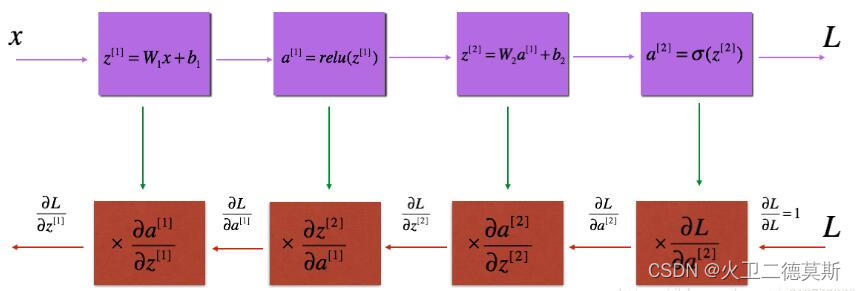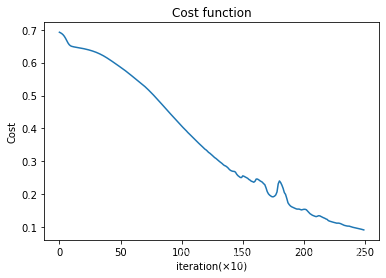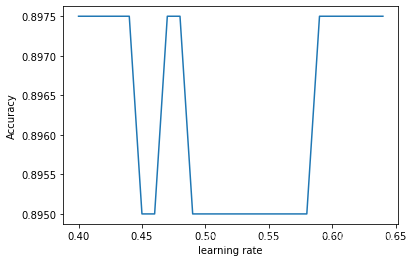写在前面:本人深度学习萌新,在参考其他第四周作业答案时,发现一些问题,比如:作者用自己的测试数据集验证函数时,连矩阵维度都对不上(就不例证了)。在自己编辑并调试后,将前两次作业的数据集(识别猫, 二维点分类)拿来验证,效果还不错,上传以供大家参考与指正。
函数库以及我的jupyter notebook
链接:https://pan.baidu.com/s/11Eu4tc1OjMHyst07PFisoA
提取码:996s
Tutorial
This assignment aims to train a L-layer neural network which enables you to freely customize its depth, dimensions of layers, activation function on each layer, as well as other hyper-parameters.
import numpy as np
import matplotlib.pyplot as plt
import h5py
from dnn_utils import sigmoid, sigmoid_backward, relu, relu_backward, tanh, tanh_backward
import lr_utils1 - Initialize the neural network's structure
As for a neural network of L layers, You are supposed to define two parameters at first:
- Depth(how many layers the network has)
- dimension of each layer(how many units each layer has)
To do this, we'll initialize the neural network's structure with a list: layer_dims = [N0, N1 ... ...NL], where Nl refers to the number of units on the l-th layer. N0, namely Nx, is defined by input_X.shape[0]. We can initialize its value as 1, because once X is input, its value will be updated.
def nn_initialize(layer_dimensions):
np.random.seed(3)
params = {}
L = len(layer_dimensions)
for l in range(1, L):
params['W' + str(l)] = np.random.randn(layer_dimensions[l], layer_dimensions[l - 1]) * 0.01
params['b' + str(l)] = np.zeros([layer_dimensions[l], 1])
assert (params['W' + str(l)].shape == (layer_dimensions[l], layer_dimensions[l - 1]))
assert (params['b' + str(l)].shape == (layer_dimensions[l], 1))
return params2 - Forward Propagation
Now introduce the parameters you need to conduct the forward propagation.
- input_x : the training set(N0, m)
- params: a dict file cotains {W[1], b[1] ... ... W[L], b[L]}. Length = 2L
- forward_functions: a list contains linear and activation functions for each layer(start from layer[1]). We will arrange linear computation for every layer so the list's varables are only activation functions(relu, sigmoid and tanh)
Return:
a dict named 'cache' including the results of forward computations {A[0], Z[1], A[1] ... ...Z[L], A[L]}
Note: the for-loop is inevitable here.
def forward(input_x, params, forward_functions):
L = len(forward_functions)
cache = {'A0': input_x}
for l in range(1, L + 1):
# retrive W[l], A[l-1], b[l]
Wl = params['W' + str(l)]
bl = params['b' + str(l)]
Al_1 = cache['A' + str(l - 1)]
Zl = np.dot(Wl, Al_1) + bl
cache['Z' + str(l)] = Zl
cache['A' + str(l)] = forward_functions[l - 1](Zl)
return cache3 - Cost function¶
Here we use the cross entropy function to compute the cost as J(w, b) = :
def compute_cost(AL, Y):
m = Y.shape[1]
cost = np.dot(Y, np.log(AL.T)) + np.dot(1 - Y, np.log(1 - AL.T))
cost /= (-m)
cost = cost.item() # transform [[a]] into a
return cost4 - Backward Propagation
The computation graghic of a 2-layer neural network is as follows:

The purple blocks represent the forward propagation, starts from the 1st layer
The red blocks represent the backward propagation, starts from the last(L-th) layer
Observing the rule of chain derivatives, we'll start with calculating dJ/dA[L]=:

For the following loops we'll input da[l], and output dW[l], db[l], dA[l-1], then store them:
By the way we don't waste to calculate and store dA[0], namely dX, this isn't useful.
def backward(Y, cache, params, backward_functions):
m = Y.shape[1]
L = len(backward_functions)
grads = {}
Al = cache['A' + str(L)]
grads['dA' + str(L)] = -(np.divide(Y, Al) - np.divide(1 - Y, 1 - Al))
for i, backfunc in enumerate(reversed(backward_functions)):
l = L - i
dAl = grads['dA' + str(l)]
Zl = cache['Z' + str(l)]
# dZl = 0
if backfunc == relu_backward:
dZl = relu_backward(dAl, Zl)
elif backfunc == sigmoid_backward:
dZl = sigmoid_backward(dAl, Zl)
elif backfunc == tanh_backward:
dZl = tanh_backward(dAl, Zl)
dWl = np.dot(dZl, cache['A' + str(l - 1)].T) / m
dbl = np.sum(dZl, axis=1, keepdims=True) / m
# We don't need to cache dA[0], namely dX
if l != 1:
dAl_1 = np.dot(params['W' + str(l)].T, dZl)
grads['dA' + str(l - 1)] = dAl_1
grads['dW' + str(l)] = dWl
grads['db' + str(l)] = dbl
return grads5 - Update the parameters
def update(params, grads, learning_rate):
L = int(len(params) / 2)
for l in range(1, L + 1):
params['W' + str(l)] -= learning_rate * grads['dW' + str(l)]
params['b' + str(l)] -= learning_rate * grads['db' + str(l)]
return params6 - Deep neural network
def dnn(input_X, Y, nn_structure, forward_functions, learning_rate, num_iterations):
# generate backward derivative functions according to forward activate functions
backward_functions = []
for func in forward_funcs:
if func == relu:
backward_functions.append(relu_backward)
elif func == sigmoid:
backward_functions.append(sigmoid_backward)
elif func == tanh:
backward_functions.append(tanh_backward)
# Redefine the number of features in nn_structure according to input_X.shape
nn_structure[0] = input_X.shape[0]
params = nn_initialize(nn_structure)
costs = []
L = len(forward_functions)
for i in range(num_iterations):
cache = forward(input_X, params, forward_functions)
AL = cache['A' + str(L)]
if i % 10 == 0:
costs.append(compute_cost(AL, Y))
grads = backward(Y, cache, params, backward_functions)
params = update(params, grads, learning_rate)
return params, costs
def predict(X, params, forward_functions):
L = len(forward_functions)
AL = forward(X, params, forward_functions)['A' + str(L)]
Y_predict = np.round(AL)
return Y_predict
def accuracy(A, Y):
m = Y.shape[1]
assert(A.shape == Y.shape)
acc = (m - np.sum(np.abs(Y - A))) / m
return acc7 - Training/Test dataset
7.1 Cat recognition
We used to conduct this with logistic regression, now try a 2-layer neural network to see if the accuracy is improved.
# Load training and test dataset and process
train_set_x_orig, train_set_y, test_set_x_orig, test_set_y, classes = lr_utils.load_dataset()
train_x_flatten = train_set_x_orig.reshape(train_set_x_orig.shape[0], -1).T
test_x_flatten = test_set_x_orig.reshape(test_set_x_orig.shape[0], -1).T
train_x = train_x_flatten / 255
train_y = train_set_y
test_x = test_x_flatten / 255
test_y = test_set_y
# initialize those hyperparameters for our dnn
layer_dims = [1, 4, 1] # units on each layer
forward_funcs = [relu, sigmoid] # activate functions in forward-propagate process
learning_rate = 0.005
num_iteration = 2500# Run training and prediction
parameters, Costs = dnn(train_x, train_y, layer_dims, forward_funcs, learning_rate, num_iteration)
plt.plot(Costs)
plt.title('Cost function')
plt.xlabel('iteration(×10)')
plt.ylabel('Cost')
plt.show()Running result:

Let's test the accracies for both training and test datasets
train_y_predict = predict(train_x, parameters, forward_funcs)
test_y_predict = predict(test_x, parameters, forward_funcs)
train_acc = accuracy(train_y_predict, train_y)
test_acc = accuracy(test_y_predict, test_y)
print(f'The training accuracy is:{train_acc*100}%')
print(f'The test accuracy is: {test_acc * 100}%')The training accuracy is:99.04306220095694% The test accuracy is: 74.0%
Performance on the test dataset is improved by 4 percent
7.2 Planar classification
7.2.1 Run with a double-sigmoid NN
from planar_utils import plot_decision_boundary, load_planar_dataset
X, Y = load_planar_dataset()
# initialize those hyperparameters for our dnn
layer_dims = [1, 3, 1] # units on each layer
forward_funcs = [sigmoid, sigmoid] # activate functions in forward-propagate process
learning_rate = 0.45
num_iteration = 10000
# Run training and prediction
parameters, Costs = dnn(X, Y, layer_dims, forward_funcs, learning_rate, num_iteration)
# Plot the Cost function
plt.subplot(1, 2, 1)
plt.plot(Costs)
plt.title('Cost function')
plt.xlabel('iteration(×10)')
plt.ylabel('Cost')
# Draw the classfication gragh
plt.subplot(1, 2, 2)
plot_decision_boundary(lambda x: predict(x.T, parameters, forward_funcs), X, Y)
plt.show()
y_predict = predict(X, parameters, forward_funcs)
test_acc2 = accuracy(y_predict, Y)
print(f'The training accuracy is: {test_acc2*100}%')
The training accuracy is: 89.5%
7.2.2 Optimize the hyperparameter α
ACC = []
Learning_rates = np.arange(0.4, 0.65, 0.01)
for lr in Learning_rates:
parameters, Costs = dnn(X, Y, layer_dims, forward_funcs, lr, num_iteration)
y_predict = predict(X, parameters, forward_funcs)
test_acc2 = accuracy(y_predict, Y)
ACC.append(test_acc2)
max_acc = max(ACC)
max_idx = ACC.index(max_acc)
plt.plot(Learning_rates, ACC)
plt.xlabel('learning rate')
plt.ylabel('Accuracy')
print(f'the optimum learning rate is {0.4+0.01*max_idx} with an accuracy of {max_acc*100}%')the optimum learning rate is 0.4 with an accuracy of 89.75%























 958
958











 被折叠的 条评论
为什么被折叠?
被折叠的 条评论
为什么被折叠?








